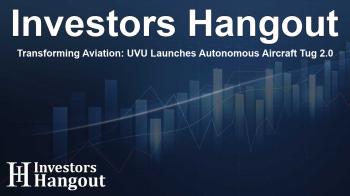Transforming Aviation: UVU Launches Autonomous Aircraft Tug 2.0

Innovative Milestone for Utah Valley University
Utah Valley University has taken a significant leap in the aviation sector with the introduction of its autonomous electric aircraft tug 2.0. This exciting development, driven by students, aims to improve fuel efficiency, lower harmful emissions, and ultimately enhance safety at airports. The aircraft tug 2.0 was recently showcased, demonstrating its potential to revolutionize the way aircraft navigate runways.
Upgraded Features of Aircraft Tug 2.0
The latest version of the tug boasts impressive enhancements. Notably, it includes an innovative hands-free coupling and decoupling system that allows for effortless attachment to the aircraft. Additionally, operators can control the tug remotely through a cellular data link, complete with a live video feed for improved situational awareness. A redesigned drivetrain contributes to the tug's superior performance and efficiency, setting new standards in airport operations.
Expert Insights into the Tug's Development
Dr. Brett Stone, a mechanical engineering professor at UVU with prior experience at Northrop Grumman, has been instrumental in the tug’s development process. He shared, "The redesign reflects months of dedicated brainstorming, testing, and teamwork. It's exciting to finally display our hard work and showcase the tug's capabilities." This collaborative effort highlights the creativity and technical skills of the students involved.
Addressing Aviation's Core Challenges
One of the primary challenges in aviation has been fuel consumption during taxiing. Traditional jet engines typically use 70-80 gallons of fuel just to move from the gate to the runway, contributing significantly to operational costs. In 2019, utilizing electric tugs could have saved over $2 million in fuel expenditure at major airports. This not only makes economic sense but also supports sustainability by cutting down on emissions, akin to removing more than 2,400 cars off the road every year.
The Student Experience
The practical experience gained by students working on this project is invaluable. Bradan Penrod, a mechanical engineering student at UVU, described the challenges faced during development. He emphasized the rigorous process of creating the attachment system, which demanded accuracy and inventive thinking. He appreciates the broader learning experience, stating that the hands-on involvement has equipped him well for future engineering endeavors.
Gaining Recognition in the Industry
The aircraft tug project has captivated industry attention due to its innovative approach. Initiated by a group of professors, the initiative provides students with real-world engineering experience. Two dedicated teams of students worked diligently for two semesters to produce the prototype, benefiting from $15,000 in funding awarded by Rocky Mountain Power Foundation.
Achievements and Future Aspirations
In 2024, the autonomous tug project won first place at the ACRP University Design Competition, earning an additional grant of $3,000. With industry interest growing, UVU is pursuing patent protection and exploring potential commercial opportunities for their cutting-edge design.
Envisioning a Sustainable Future for Aviation
Looking ahead, Utah Valley University plans to expand the tug's capabilities for use with larger regional jets, such as the Embraer and Canadair models, and eventually the Boeing 737 and Airbus A320. The team also sees additional applications for the tug, including autonomous operation for baggage transport and snow removal, presenting various operating modes: pilot-controlled, remote-operated, and fully autonomous.
Optimism for Future Innovations
Professor Stone remains positive about the tug's potential to transform the aviation landscape. "This technology illustrates how student-led initiatives can significantly contribute to aviation’s sustainability efforts," he stated. With ongoing advancements, UVU continues to inspire future generations of engineers while addressing pressing environmental concerns in aviation.
Frequently Asked Questions
What is the purpose of the autonomous aircraft tug 2.0?
The autonomous aircraft tug 2.0 aims to reduce fuel consumption, lower emissions, and enhance safety during aircraft taxiing.
Who developed the aircraft tug at UVU?
The development involved students from the mechanical engineering and computer science departments, led by professors including Dr. Brett Stone.
What are some key features of the new aircraft tug?
The tug features a hands-free coupling system, remote control operation, and a redesigned drivetrain for improved performance.
What recognition has the aircraft tug project received?
The project won first place in the ACRP University Design Competition and secured additional funding.
What are the future plans for the tug?
Future plans include scaling the tug for larger aircraft and exploring additional applications, such as towing baggage and snowplows.
About The Author
Contact Riley Hayes privately here. Or send an email with ATTN: Riley Hayes as the subject to contact@investorshangout.com.
About Investors Hangout
Investors Hangout is a leading online stock forum for financial discussion and learning, offering a wide range of free tools and resources. It draws in traders of all levels, who exchange market knowledge, investigate trading tactics, and keep an eye on industry developments in real time. Featuring financial articles, stock message boards, quotes, charts, company profiles, and live news updates. Through cooperative learning and a wealth of informational resources, it helps users from novices creating their first portfolios to experts honing their techniques. Join Investors Hangout today: https://investorshangout.com/
The content of this article is based on factual, publicly available information and does not represent legal, financial, or investment advice. Investors Hangout does not offer financial advice, and the author is not a licensed financial advisor. Consult a qualified advisor before making any financial or investment decisions based on this article. This article should not be considered advice to purchase, sell, or hold any securities or other investments. If any of the material provided here is inaccurate, please contact us for corrections.

